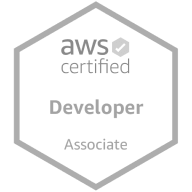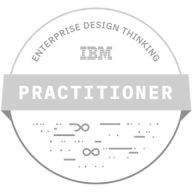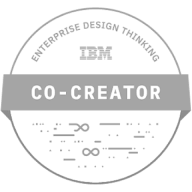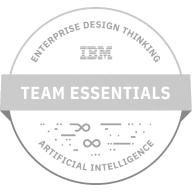![How Much Does It Cost to Build a Website [Full Pricing Guide]](assets/uploads/blog/20251104/cover-small.png)
How Much Does It Cost to Build a Website [Full Pricing Guide]
Want to know more? — Subscribe
Building a website in 2025? You're not alone. Every 3 seconds, a new website goes live on the internet. But here's what most business owners discover the hard way: that "simple $500 website" can quickly balloon into a $15,000+ investment when you factor in the hidden costs nobody talks about.
We've personally seen agencies charge clients $1,500 just to swap out stock photos and add text to a template—the same template they use for every client. We've also witnessed businesses spend $50,000 on a "premium" website that performed worse than a $2,000 WordPress build.
The truth? Website costs are all over the map, ranging from your sweat equity and $120 annually to enterprise solutions exceeding $300,000. This isn't just another pricing guide—it's your roadmap to avoiding the expensive mistakes that cost business owners thousands.
How Much Does a Website Cost in 2025?
Here's the reality: website costs can range from free (if you're willing to invest your time) to hundreds of thousands of dollars. The key is understanding what you're actually paying for.
But here's what nobody tells you: the initial build is just the beginning. Most small businesses end up spending $500 - $5,000 annually on maintenance, updates, and improvements they didn't budget for.
Factors Affecting the Average Cost of Developing a Website
Think of your website like a building project. You wouldn't use the same budget for a small shop as you would for a hospital, right? Website costs work similarly—they scale dramatically based on complexity, purpose, and requirements.
Website Size and Scope
A 5-page brochure site costs a fraction of a 500-page enterprise platform. Each additional page, feature, and integration multiplies both time and cost. The difference between "simple" and "complex" isn't just volume—it's architectural complexity.
Basic Informational Websites
These are small, simple sites that offer only basic information. They are often used by small businesses, local shops, freelancers, or individuals who just need an online presence. Think of it like a digital business card. A typical informational website might have:
- A homepage
- An about page
- A contact page with a form or phone number
- А services page
Because the content is simple and rarely changes, these sites require minimal time to design and develop. Many can even be built using drag-and-drop website builders like Wix, Squarespace, or WordPress templates. The cost of such a site in 2025 typically ranges from $500 to $5,000, depending on whether you undertake the project yourself or hire a professional.
Blog or Portfolio Websites
A step above an informational site is a blog or portfolio. These websites require additional functionality because they are updated regularly with new posts or projects. A blog typically includes categories, search tools, and a comment section. A portfolio site may need image galleries or video sections to showcase creative work. While these are not too complex, they require a proper content management system (CMS) so the owner can update them easily. WordPress is the most common platform for this. The cost for such a site can range from $2,000 to $10,000, depending on custom design and features.
E-Commerce Websites
E-commerce sites are more advanced because they enable visitors to purchase products or services online. These websites need:
- Product listings with images and descriptions
- Shopping cart functionality
- Secure payment systems
- Inventory management
- Shipping and tax calculation
Additionally, e-commerce websites require robust hosting and security, as they handle sensitive customer data. Shopify, WooCommerce (on WordPress), and Magento are popular platforms for online stores. A small e-commerce store might cost $5,000 to $20,000, while a large online shop with thousands of products could cost $50,000 or more.
Web Applications and Custom Platforms
The most expensive type of website is a custom-built platform or web application. These are not just websites—they are full online systems that perform specific tasks. Examples include:
- Marketplaces like Airbnb or Etsy
- Social networks like LinkedIn
- Online booking systems for hotels or doctors
- Learning platforms like Udemy
These projects require complex coding, databases, and integrations with other services. They also need more time for testing and security. As a result, prices can range from $50,000 to over $250,000, depending on the features and scale.
Why Type of Website Matters
The type of website determines not only the initial development cost but also long-term expenses. For example, an informational site may have very low monthly costs, while an e-commerce store or custom platform needs ongoing maintenance, security, and server upgrades. Businesses should carefully consider their goals before deciding on the type of website.
Website Type and Purpose
Each type requires varying levels of technical complexity, investment, and ongoing maintenance to achieve its intended purpose.
| Criteria | Informational Sites | E-commerce Platforms | Web Applications | Enterprise Solutions |
|---|---|---|---|---|
|
Development Time |
2-4 weeks |
6-12 weeks |
3-8 months |
6-18 months |
|
Initial Cost |
$500-$5,000 |
$3,000-$25,000 |
$15,000-$150,000 |
$100,000 - $2,000,000+ |
|
Monthly Hosting |
$10-$50 |
$50-$200 |
$200-$1,000 |
$2,000-$20,000+ |
|
Pages/Features |
5-8 pages, basic forms |
15-50 products, cart, checkout |
Custom features, user accounts |
Unlimited features, integrations |
|
User Capacity |
1,000-10,000 visitors |
10,000-100,000 visitors |
1,000-10,000 concurrent |
100,000+ concurrent |
|
Uptime Guarantee |
99.5% |
99.9% |
99.95% |
99.99% |
|
Page Load Speed |
2-4 seconds |
1-3 seconds |
<2 seconds |
<1 second |
|
Security Level |
Basic SSL |
PCI DSS compliance |
Advanced encryption |
Military-grade protocols |
|
Database Required |
Optional |
MySQL/PostgreSQL |
Advanced systems |
Enterprise clusters |
|
Third-party Integrations |
1-3 basic tools |
5-10 payment/shipping |
10-20 APIs |
20-100+ systems |
|
Mobile Responsive |
Standard |
Required |
Essential |
Mandatory |
|
SEO Optimization |
Basic |
Advanced |
Custom |
Enterprise-level |
|
Backup Frequency |
Weekly |
Daily |
Real-time |
Continuous with 7-year retention |
|
Annual Maintenance |
$500-$2,000 |
$2,000-$8,000 |
$15,000-$50,000 |
$50,000 - $500,000 |
|
Security Updates |
$0-$500 |
$1,000-$3,000 |
$5,000-$15,000 |
$20,000 - $100,000 |
|
Feature Additions |
$500-$2,000 |
$2,000-$10,000 |
$10,000-$50,000 |
$50,000 - $500,000 |
|
Break-even Period |
3-6 months |
6-12 months |
12-24 months |
18-36 months |
|
Maintenance Time |
2-3 hours/month |
5-10 hours/month |
20-40 hours/month |
Dedicated team required |
|
Revenue Potential |
Lead generation |
Direct sales |
Subscription/usage fees |
Operational efficiency gains |
|
Transaction Fees |
None |
2.9% + $0.30 per sale |
Variable by model |
Enterprise rates negotiated |
|
Best For |
Small businesses, consultants |
Online retailers |
SaaS companies |
Fortune 500, large corps |

|
||||
Quick Decision Guide
Your website works 24/7, never calls in sick, and scales infinitely. The question isn't what you can afford to build—it's what you can afford to lose by not building it.
Functionality Requirements
Here's where costs can explode unexpectedly. That "simple" contact form becomes expensive when you need multi-step workflows, conditional logic, CRM integration, and automated follow-ups. Every "can we also add..." request during development typically costs $500-$2,000 in work.
You said: "Just add a simple contact form"
You got:
A $5,000 custom system
Here's how it always happens.
| What You Think You Want | What You Actually Need | Cost Impact |
|---|---|---|
|
Basic contact form |
Multi-step workflow with conditional logic |
+$1,500 |
|
"Send to email" |
CRM integration + lead scoring |
+$2,000 |
|
Simple confirmation |
Automated follow-up email sequences |
+$1,000 |
|
Standard fields |
Dynamic fields based on user selection |
+$800 |

|
||
The "Can We Also Add..." Price List
Every additional request costs real money:
- "Can we also add file uploads?" → +$500
- "Can we also add calendar booking?" → +$1,200
- "Can we also add payment processing?" → +$2,000
- "Can we also add user accounts?" → +$1,500
- "Can we also add mobile optimization?" → +$800
- "Can we also add spam protection?" → +$400
Technology Stack Decisions
Your technology choice determines your speed, budget, and sanity. Choose wisely—this decision will haunt you for years.
Path 1: WordPress/CMS
Perfect for restaurants, consultants, small businesses, and anyone who needs to look professional without reinventing the wheel. You'll have a website that works while your competitors are still debating custom features.
WordPress gives small ideas a big stage—powerful enough for enterprises, simple enough for beginners.
 Slava Vaniukov
Slava Vaniukov- Launch time: 2-6 weeks
- Initial cost: $500-$10,000
- Control level: Medium (good until you want something weird)
- Annual maintenance: $2,000-$5,000
- Scalability: Handles 90% of business growth
That moment when you need something WordPress wasn't designed for? You'll either pay premium prices to force it or accept "close enough." Plugin conflicts will randomly break your site at 2 AM.
Choose This Path If: You want proven, cost-effective, and fast deployment
Path 2: Custom Development
"Every feature, every detail, every interaction—crafted precisely to match your requirements and exceed your expectations" — Andrii Horiachko, Co-Founder of Softermii.
Your website becomes your competitive advantage. Every feature works exactly how your business operates. You can pivot, scale, and dominate without platform limitations.
- Launch time: 3-12 months (add 50% to whatever they quote)
- Initial cost: $15,000-$200,000+
- Control level: Total (you own every pixel and function)
- Annual maintenance: $20,000-$100,000+
- Scalability: Unlimited (if you can afford it)
Budget overruns are guaranteed. Timeline delays are standard. You'll need dedicated technical staff forever. That "simple" change costs $5,000 because it affects the entire system.
Choose This Path If: You have deep pockets and unique business requirements
Path 3: Hybrid Approach
You get 80% of custom development benefits at 40% of the cost. Launch faster than full custom, with more flexibility than pure CMS. Perfect for businesses ready to scale.
Best of both worlds—CMS speed with custom power. We deliver solutions that launch quickly like a CMS but scale and perform like custom-built enterprise software
 Vladimir Zhmak
Vladimir Zhmak- Launch time: 6-16 weeks
- Initial cost: $5,000-$50,000
- Control level: High (custom where it matters, standard where it doesn't)
- Annual maintenance: $5,000-$15,000
- Scalability: Excellent for growing businesses
More complex than straight WordPress, more expensive than no-code. You need developers who understand both CMS and custom development—harder to find, more expensive to hire.
Choose This Path If: You're growing fast and need specific features CMS can't deliver
Path 4: No-Code Platforms
Perfect for testing ideas, launching MVPs, and getting online fast. Modern no-code platforms are surprisingly powerful and look genuinely professional.
Launch in days, no developers needed, change anything instantly. We've built a platform that puts the power of professional web development in your hands, without writing a single line of code
 Slava Vaniukov
Slava Vaniukov- Launch time: 1-4 weeks
- Initial cost: $0-$5,000
- Control level: Low (beautiful templates, limited customization)
- Annual maintenance: $500-$3,000 (mostly subscription fees)
- Scalability: Limited but improving rapidly
Hit the customization wall and you're stuck. Want to migrate your data? Good luck. Platform changes its pricing or features? You adapt or start over.
Choose This Path If: Speed matters more than control, or you're validating a business idea
| Your Situation | Recommended Path | Why |
|---|---|---|
|
Startup validating idea |
No-Code |
Speed beats perfection |
|
Small business going digital |
WordPress/CMS |
Proven, affordable, works |
|
Growing company with unique needs |
Hybrid |
Balanced cost and flexibility |
|
Enterprise with complex processes |
Custom |
Control justifies the cost |

|
||
Design Complexity
Visual design isn't just about "looking pretty"—it's about user experience architecture. A simple, clean design often costs more than a busy one because simplicity requires strategic thinking. Custom graphics, animations, and interactive elements can add $5,000 - $20,000 to your project.
Template vs. Custom Design
There are two main approaches to web design: using pre-made templates or creating a custom design.
Templates: Many website builders and content management systems offer templates that you can customize with your own text and images. Templates are affordable and fast to use. They may cost only a few hundred dollars, or even be free. However, templates can feel generic, and other websites might look very similar to yours.
Pros:
- Low cost (often free or just a few hundred dollars).
- Fast setup — a site can be launched within days.
- Easy to use without deep technical knowledge.
- Wide variety available on WordPress, Wix, Squarespace, etc.
- Great for MVPs or simple brochure-style websites.
Cons:
- Generic look, lacks uniqueness.
- Limited flexibility — hard to make major changes.
- High chance other sites will look very similar.
- Possible issues with speed optimization and SEO.
- Difficult to scale for complex business needs.
Custom Design: A professional designer or agency can create a unique design that matches your brand's identity. This process involves research, wireframes, mockups, and revisions before final development. Custom design takes more time and effort, so costs can range from $2,000 to $20,000 depending on the complexity.
Pros:
- Unique look tailored to your brand.
- Full flexibility — any features or elements can be built.
- Better user experience (UX), which boosts trust and conversions.
- Easier to scale and grow over time.
- Optimized for SEO, speed, and mobile devices.
Cons:
- Higher cost ($2,000 – $20,000+).
- Longer development time (weeks or even months).
- Requires ongoing collaboration with designers or an agency.
- Might be overkill for very simple websites (like a one-time event landing page).
Importance of User Experience (UX)
User experience refers to the ease and enjoyment visitors experience when using your website. A visually appealing site that is difficult to navigate will drive customers away. On the other hand, a site with smooth navigation, fast loading, and clear layouts will keep people engaged. UX design includes:
- Intuitive menus and navigation
- Clear calls-to-action (buttons, forms, links)
- Fast load times
- Mobile responsiveness
- Accessibility for people with disabilities
Investing in UX design can increase conversions and sales, which is why many businesses choose to allocate more resources to it.
Visual Branding and Graphics
Another factor that affects the cost is the extent of branding and custom graphics included. Some businesses need simple logos and stock photos, while others require:
- Custom illustrations
- Animated graphics
- High-quality photography or video
- Interactive elements like sliders or product visualizers
These creative elements add uniqueness but also increase design hours and expenses.
Responsive and Mobile-Friendly Design
By 2025, mobile traffic will make up the majority of web usage. That means every website must look and work perfectly on phones and tablets, not just desktops. Responsive design adapts layouts to different screen sizes. Creating and testing this flexibility adds time and cost. Ignoring mobile design is no longer an option if you want to reach your audience.
Why Design and UX Matter for Cost
While some business owners may try to save money by choosing a cheap template, cutting corners on design can hurt results. A poorly designed site may look outdated, frustrate users, and lower trust. On the other hand, a well-designed site creates a professional image and helps turn visitors into customers. In many cases, investing more in design pays for itself through higher conversions and stronger brand identity.
Mobile and Device Optimization
You've been lied to. That "responsive design" you paid for? It's the digital equivalent of squeezing a refrigerator through a doggy door. Technically possible, but nobody's happy about it.
While you're admiring your beautiful desktop website, 6 out of 10 visitors are rage-quitting on their phones after 3 seconds of frustration.
Level 1: The Squeezebox ($2,000-$5,000)
Your desktop site crammed into mobile screens. Works like a suit that's three sizes too small—technically wearable, completely uncomfortable. 70% of mobile visitors bounce immediately.
Level 2: The Thumb-Friendly Revolution ($8,000-$15,000)
Purpose-built for fingertips and short attention spans. Navigation designed for one-handed use while walking. Mobile conversion rates make sense.
Level 3: The App-Like Experience ($15,000-$30,000)
Progressive web apps that feel native. Offline functionality, push
notifications, home screen installation. Your website becomes as smooth as
Instagram.
Level 4: The Mobile Fortress ($25,000-$50,000)
Separate mobile site with dedicated development team. Maximum control, maximum performance, maximum maintenance costs. Only necessary for complex e-commerce or web applications.
Third-Party Integrations
You've built the perfect website. Then comes the innocent question: "Can you connect it to our payment system?" What seems like a simple request just turned your $5,000 project into a $15,000 adventure.
The Integration Reality Check
Every third-party connection is like adding another engine to your car. Sure, it might run faster, but now you have twice as many things that can break, twice the maintenance, and a mechanic bill that makes you question your life choices.
The brutal math: Each integration typically adds 20-50% to your development timeline and 30-100% to your costs. That "quick connection" to your CRM system? It's never quick.
The Cost Breakdown That Kills Budgets
Payment Gateways: $500-$2,000. Connecting Stripe or PayPal looks simple until you need to handle recurring billing, tax calculations, refunds, and international currencies. Suddenly, you're building a mini accounting system.
CRM Integration: $1,000-$5,000. Syncing customer data between your website and Salesforce seems straightforward. Then you discover data mapping conflicts, duplicate record handling, and real-time sync requirements that require custom development.
Marketing Automation: $800-$3,000. Connecting Mailchimp or HubSpot starts easy but grows complex when you need behavioral triggers, lead scoring, and custom field mapping. Each automation rule adds complexity and cost.
Custom APIs: $2,000-$10,000+. Connecting to proprietary business systems is where costs explode. Legacy systems with inadequate documentation can transform a straightforward integration into months of custom development.
Performance and Security Requirements
Every visitor makes a subconscious decision in 3 seconds: stay or leave. If your site doesn't load fast and feel secure, they're gone—taking their money, trust, and recommendations with them.
What Performance and Security Actually Cost
Performance Optimization: +$2,000-$8,000. Image compression, code minification, caching systems, and content delivery networks. Your site loads in under 2 seconds, compared to the industry average of 6 seconds.
SSL Certificates and Security: +$500-$3,000. Beyond basic SSL certificates, you also need malware scanning, firewall protection, and security monitoring, as a single hack can cost over $50,000 in recovery and reputation damage.
Specialized Hosting: +$50-$500 monthly. Shared hosting for $10/month is like parking a Ferrari in a garage with 100 other cars—cramped, slow, and risky. Quality hosting with proper security and speed optimization is business insurance.
Content Strategy and Creation
You've planned for design, development, and hosting. You've got a stunning website that loads fast and looks like a million bucks. Then reality hits: your beautiful website has nothing interesting to say.
The shocking truth: Your $20,000 website with amateur content will be outperformed by a $5,000 website with professional content every single time.
The Great Content Awakening
Day 1: "We'll just write the content ourselves. How hard can
it be?"
Day 30: Staring at a blank page, wondering why
writing 500 words about your business feels impossible
Day 60:
Launching with placeholder text that says "Lorem ipsum dolor sit amet"
Day 90:
Watching competitors with better content steal your customers
What Professional Content Actually Includes
Strategic Copywriting: $2,000-$8,000
Not just pretty words—psychological triggers,
search optimization, and conversion-focused messaging. Every sentence has a
purpose: keep reading, build trust, take action.
Professional Photography: $1,000-$5,000
High-quality images that actually represent your
business. Stock photos scream "amateur hour." Custom photography says, "We're
serious professionals."
Content Strategy: $1,500-$3,000
The
blueprint for what content goes where and why. This isn't random text
filling—it's strategic communication that guides visitors toward your
goals.
Video Content: $2,000-$10,000
Professional video increases engagement by 300%. A
well-crafted explainer video can replace pages of text and convert browsers
into buyers.
Website Development Price Based on Website Type and Complexity
Understanding website costs by type is like comparing construction projects—a food truck, retail store, and shopping mall all serve commerce but require vastly different investments. Here's what each website type actually costs in 2025, with the reality checks most pricing guides skip.
Simple Websites ($500 - $8,000)
Landing Pages: $500 - $5,000
Single-purpose pages designed for one specific action (sign-ups, purchases, downloads). Don't let the simplicity fool you—effective landing pages require psychological understanding of user behavior and extensive A/B testing.
Real cost factors:
- Basic design: $500-$2,000
- Conversion optimization: $1,000-$3,000 additional
- A/B testing setup: $500-$1,500
Examples: Product launches, event registrations, lead magnets
Business Card/Portfolio Sites: $1,200 - $6,000
3-8 pages showcasing your business, services, or creative work. These sites prioritize visual impact and credibility over complex functionality.
What drives costs:
- Custom photography integration: +$500-$2,000
- Interactive portfolios: +$1,000-$3,000
- Professional copywriting: +$800-$2,500
Examples: Photographers, consultants, small service businesses
Blog Websites: $1,500 - $7,000
Content-focused sites require content management systems, commenting functionality, and SEO optimization to manage and promote their content effectively. The technical simplicity masks the content strategy complexity.
Hidden expenses:
- Content management training: $200-$500
- SEO plugin setup: $300-$800
- Comment moderation systems: $200-$600
Examples: Personal blogs, company news sites, niche publications
Medium Complexity Websites ($7,000 - $25,000)
Corporate Websites: $8,000 - $20,000
Multi-departmental sites with complex information architecture, employee portals, client resources, and integration requirements.
Cost multipliers:
- User role management: +$2,000-$5,000
- Document libraries: +$1,500-$4,000
- Multi-language support: +$3,000-$8,000
Examples: Professional services firms, healthcare organizations, educational institutions
News/Magazine Sites: $10,000 - $15,000
High-volume content sites requiring sophisticated content management, subscription systems, and advertising integration.
Complexity factors:
- Paywall implementation: +$3,000-$7,000
- Editorial workflow systems: +$2,000-$5,000
- Advertisement management: +$2,000-$6,000
Examples: Local newspapers, industry publications, digital magazines
Directory Websites: $12,000 - $25,000
Listing-based sites connecting users with services or businesses. These require search functionality, user-generated content management, and often payment processing.
Development challenges:
- Advanced search filters: +$3,000-$8,000
- User submission systems: +$2,000-$6,000
- Review/rating functionality: +$2,000-$5,000
Examples: Business directories, service marketplaces, event listings
Complex Websites ($25,000 - $150,000+)
E-commerce Sites: $15,000 - $100,000
Online stores requiring payment processing, inventory management, security compliance, and performance optimization for conversions.
Price reality by complexity:
- Small store (under 50 products): $15,000-$35,000
- Medium business (50-500 products): $35,000-$75,000
- Enterprise (500+ products): $75,000-$200,000+
Cost drivers:
- Payment gateway integrations: $2,000-$8,000
- Inventory management: $5,000-$15,000
- Security compliance: $3,000-$10,000
- Multi-vendor capability: +$20,000-$50,000
Examples: Online retailers, subscription boxes, digital marketplaces
SaaS Websites: $25,000 - $100,000
Marketing sites for software companies requiring integration with the main product, user onboarding flows, and complex conversion tracking.
Specialized requirements:
- Product demo integration: $5,000-$15,000
- User dashboard previews: $8,000-$20,000
- Trial signup flows: $3,000-$10,000
- Customer success portals: $10,000-$30,000
Examples: Software companies, web applications, digital tools
Educational Platforms: $30,000 - $150,000
Learning management systems with course creation, progress tracking, assessment tools, and often payment processing for course sales.
Feature complexity:
- Course creation tools: $10,000-$30,000
- Progress tracking: $8,000-$20,000
- Assessment systems: $12,000-$35,000
- Video streaming integration: $15,000-$40,000
Examples: Online courses, corporate training, certification programs
Enterprise-Level Websites ($100,000+)
Marketplace Platforms: $100,000 - $500,000
Multi-vendor platforms requiring complex user management, transaction processing, dispute resolution, and high-performance architecture.
Web Portals: $150,000 - $300,000
Internal or client-facing systems with extensive user management, document handling, and integration requirements.
Social Media Platforms: $200,000 - $1,000,000+
Community-driven sites with user-generated content, real-time features, and massive scalability requirements.
The Reality Behind These Numbers
Why such wide ranges? Because "e-commerce site" can mean a 10-product craft store or a multi-vendor marketplace with thousands of sellers. The devil is in the details:
- A "simple" contact form costs $200
- That same form with CRM integration, conditional logic, and automated workflows costs $3,000
Time Investment Translation:
- Landing page: 50-80 development hours
- Corporate website: 150-300 development hours
- E-commerce platform: 500-2,000+ development hours
- Marketplace: 1,500-5,000+ development hours
The 80/20 Rule in Action: Typically, 80% of functionality costs 20% of the budget, while the final 20% of features (advanced integrations, custom workflows, performance optimization) consume 80% of the budget.
Budget Smarter: Start with core functionality that solves your primary business problem. That elaborate product configurator can wait until you're actually selling products that need configuring.
Website Costs Based on Cooperation Model
The team you choose can make or break both your budget and your project timeline. Here's the reality behind each option, based on analyzing hundreds of website projects and their outcomes.
Let's use a real-world scenario: a complex website requiring 1,000 development hours (typical for a custom e-commerce platform or SaaS website). Here's what each approach actually costs:
| Team Type | Total Cost | Hidden Costs | Success Rate |
|---|---|---|---|
|
In-House Team |
$90,000-$150,000 |
+$50,000 annual overhead |
65% |
|
Local Agency |
$80,000-$200,000 |
+$15,000 project management |
85% |
|
Outsource Agency |
$25,000-$60,000 |
+$5,000 communication overhead |
75% |
|
Freelancer Team |
$20,000-$45,000 |
+$8,000 coordination costs |
45% |

|
|||
Success rate = delivered on time, on budget, with working functionality
In-House Development Team
Most small to medium businesses can't justify a full-time development team for a single website project.
Annual Investment Required: $300,000 - $600,000
- Senior Developer: $120,000 - $180,000
- Frontend Developer: $90,000 - $130,000
- Designer: $70,000 - $110,000
- Project Manager: $80,000 - $120,000
- Benefits, taxes, equipment: +30-40% of salaries
When It Makes Sense:
- You're a tech company needing ongoing development
- Multiple websites/applications in your pipeline
- Sensitive data requiring internal control
- Budget exceeding $500,000 annually for web projects
Building an effective in-house team takes 6-12 months. Most businesses need their website much sooner.
| Pros | Cons |
|---|---|
|
Complete control and oversight |
Massive upfront investment |
|
Deep understanding of your business |
Recruitment and retention challenges |
|
Immediate availability for changes |
Limited expertise breadth |
|
Long-term asset building |
High risk if key team members leave |

|
|
Local Development Agencies
Project Range: $25,000 - $200,000 for complex websites
Hourly Rates: $75 - $300 per hour (varies by city and expertise)
The Agency Premium Breakdown:
- Senior strategist: $150-$300/hour
- Senior developer: $100-$200/hour
- Designer: $75-$150/hour
- Project manager: $80-$150/hour
- Account management: $60-$120/hour
When Local Agencies Excel:
- Complex projects requiring strategic thinking
- Industries with compliance requirements
- Businesses needing an ongoing partnership
- Projects where face-to-face meetings matter
Good agencies are often booked 2-3 months out. Plan accordingly.
| Pros | Cons |
|---|---|
|
Proven processes and quality assurance |
Higher costs than other options |
|
Full-service capabilities (strategy to maintenance) |
Less flexibility in team composition |
|
Professional accountability and contracts |
May have minimum project requirements |
|
No time zone issues |
Potential for over-engineering solutions |

|
|
Freelancer Approach
Project Range: $5,000 - $50,000, depending on team composition
Individual Rates: $25 - $150 per hour
The Freelancer Math:
- WordPress developer: $35-$80/hour
- Custom developer: $50-$150/hour
- Designer: $30-$100/hour
- Project coordinator: $25-$60/hour
You become the project manager, which typically adds 15-25% to the total timeline.
When Freelancers Work Best:
- Simple to moderate complexity projects
- Tight budgets with flexible timelines
- You have project management experience
- Clear, well-defined requirements
The Success Factors:
- Hire freelancers who've worked together before
- Use detailed contracts with milestone payments
- Build in 20-30% timeline buffer
- Have a backup plan for each role
| Pros | Cons |
|---|---|
|
Most cost-effective option |
Higher coordination overhead |
|
Access to specialized skills globally |
Variable quality and reliability |
|
Flexible team scaling |
No unified accountability |
|
Direct communication with developers |
Potential for project abandonment |

|
|
Outsourcing Agencies
Project Range: $15,000 - $80,000 for complex websites
Regional Rate Differences:
Hourly rates for website development vary greatly depending on where your team is located:
- Eastern Europe: $25 – $75/hour
- Asia (India, Philippines): $15 – $50/hour
- Latin America: $20 – $65/hour
- Africa: $15 – $45/hour
At first glance, the cheapest options may look attractive, but the lowest price often comes with hidden risks. In regions like Asia and Africa, you can certainly find talented developers; however, the market also suffers from a high rate of scams, inconsistent quality, and communication barriers. What appears to be savings upfront can quickly turn into extra costs for fixes, delays, or even restarting the project with a new team.
Eastern Europe stands out as the best balance of price and quality. Development rates here are still lower than in the US or Western Europe, yet the level of expertise is world-class. The region boasts a robust tech education system, a long history of outsourcing to global companies, and a work mindset that closely aligns with Western business culture. This means fewer misunderstandings, smoother communication, and higher reliability.
Quality Indicators to Look For:
- English proficiency certification
- Portfolio with similar project complexity
- Client testimonials from your industry
- Established processes and project management
- Cultural compatibility with your business style
When Outsourcing Excels:
- Well-defined projects with clear requirements
- Budget-conscious businesses needing professional results
- Projects where ongoing maintenance is important
- Companies comfortable with remote collaboration
Success Strategies:
- Invest time in vetting agencies thoroughly
- Start with a small pilot project
- Establish clear communication protocols
- Plan for 1-2 hour time zone overlap daily
| Pros | Cons |
|---|---|
|
Excellent value proposition |
Time zone coordination challenges |
|
Access to specialized expertise |
Potential communication barriers |
|
Proven agency processes |
Cultural differences in work approach |
|
Often include post-launch support |
Due diligence required for vetting |

|
|
The Strategic Decision Framework
Summary so it's easier to compare at a glance:
| Option | Choose When | Best Fit Summary |
|---|---|---|
|
In-House Team |
- Annual web development budget > $300,000 - Highly sensitive/proprietary requirements - Continuous development needs |
Best for large enterprises or organizations needing full control, security, and ongoing innovation. |
|
Local Agency |
- Project budget > $25,000 - Complex integration requirements - Need for ongoing strategic partnership - Compliance-heavy industries |
Ideal for mid-to-large businesses that want accountability, proven processes, and local alignment. |
|
Outsourcing Agency |
- Budget-conscious but quality-focused - Clear requirements and specifications - Timeline flexibility (2–4 weeks longer) - Comfortable with remote collaboration |
Best for companies seeking cost savings with professional delivery and post-launch support. |
|
Freelancers |
- Budget < $15,000 - Simple to moderate complexity - You can manage the project - Timeline is flexible |
Suited for startups or small projects where cost efficiency matters more than structure. |

|
||
The Hybrid Approach (Often the Smartest)
Many successful projects use a combination:
- Local agency for strategy and design
- Outsourcing agency for development
- Freelancers for ongoing maintenance
This approach balances cost, quality, and risk while leveraging each team type's strengths.
The Hidden Costs in Website Development
Your $10,000 website quote just became $25,000. Here's why and how to protect yourself from these common budget explosions.
The Functionality Trap
What starts as a simple contact form quickly becomes expensive when you realize you need multi-step workflows, conditional logic, CRM integration, and automated follow-ups. Every "can we also add" request during development typically incurs an additional cost of $500-$2,000 in work.
A basic contact form costs around $500, but adding conditional fields, database integration, and automated responses can increase the cost to $2,000-$3,500. The functionality requirements often multiply costs by 200-400% over initial quotes.
Content Creation Reality
Most businesses assume they'll write their own content and take their own photos. Three months later, they're still staring at blank pages while competitors with professional content steal their customers.
Professional copywriting, photography, and content strategy easily add $3,000-$15,000 to your project. However, great content often matters more than fancy design for actual business results. A $5,000 website with professional content will consistently outperform a $20,000 website with amateur copy.
True Mobile Optimization Costs
"Responsive design" often means your desktop site squeezed into a mobile screen. True mobile optimization requires redesigning the entire user experience for touch navigation and thumb-friendly interfaces.
With 60% of traffic coming from mobile devices, implementing proper mobile-first development can add $5,000 to $15,000 to your budget. This isn't just making things fit smaller screens—it's rebuilding your site's functionality for mobile users.
Third-Party Integration Expenses
Each system connection multiplies development complexity and costs. Payment gateways typically cost between $500 and $2,000 to integrate properly. CRM system connections range from $1,000 to $5,000. Marketing automation platforms add $800-$3,000. Custom API integrations can cost between $2,000 and $10,000 or more.
Every integration adds 30-100% to development time because systems rarely communicate perfectly with each other. Data mapping, error handling, and ongoing maintenance compound these costs.
Performance and Security Requirements
Fast-loading, secure websites require additional development time, specialized hosting, SSL certificates, and ongoing monitoring. Budget an extra 15-25% for performance optimization—it's cheaper than losing customers to slow load times.
Proper security measures cost $500-$3,000 upfront but prevent the $50,000+ recovery costs of a security breach. Performance optimization adds $2,000-$8,000 but keeps 53% of visitors who abandon slow-loading sites.
Revision and Change Management
Initial quotes typically include three rounds of revisions, but reality brings endless stakeholder feedback and changing requirements. Minor text changes cost between $100 and $300 each. Layout modifications run $500-$1,500. Functionality changes can cost between $1,000 and $5,000 each.
Scope creep is the biggest budget killer in web development. Define everything precisely before development begins, or pay exponentially more for changes mid-project.
Launch Infrastructure Costs
Domain registration, hosting setup, SSL certificates, email configuration, analytics implementation, and legal compliance add $1,000-$5,000 in first-year costs that rarely appear in initial quotes.
These seem like small expenses individually, but they compound quickly and are essential for your website to function properly.
Ongoing Maintenance Requirements
Websites aren't "set it and forget it" investments. Software updates, security patches, plugin compatibility fixes, and performance monitoring typically cost 15-25% of your initial development investment annually.
A $20,000 website requires $3,000 to $5,000 in annual maintenance to stay secure, fast, and functional. Factor this into your total cost of ownership from day one.
Technology Stack Decisions
Your platform choice determines long-term costs and capabilities. WordPress seems economical until you need custom functionality. Custom development appears expensive until you calculate the flexibility benefits. No-code platforms offer speed and affordability until you hit their limitations.
Choose your technology stack based on where your business is going, not just where you are today. The cheapest option upfront often proves to be the most expensive in the long run.
Training and Support Needs
After launch, you actually need to use your new website—basic content management training costs between $500 and $1,500. Advanced feature training runs $1,000-$3,000. Ongoing support contracts incur a monthly fee of $200 to $500.
Budget 10-15% of your development cost for proper training and documentation. Otherwise, you'll pay more for support calls every time you need to make simple updates.
Protection Strategies
Obtain itemized quotes that break down the cost of each feature. Define your complete scope before development begins—write down every requirement, integration, and desired feature. Budget 30% above the initial quote for inevitable hidden costs and changes.
Consider phased development, where you launch with core functionality first and then add complexity through planned updates. This spreads costs over time and lets you validate features before investing heavily.
Website Costs Based on Team Location
Location dramatically impacts development costs, but it's not just about finding the cheapest rates. Quality, communication, and cultural alignment often matter more than hourly savings. Here's the real breakdown of global development costs and what you actually get for your money.
North America: Premium Pricing, Premium Service
North America remains the highest-cost region, but the rates reflect extensive expertise, reliability, and direct collaboration. Clients in regulated industries or projects requiring frequent communication often prefer North American teams despite the premium pricing.
| Region | Hourly Rates | Project Range | Key Tech Hubs | Secondary/Other Markets |
|---|---|---|---|---|
|
United States |
$75 – $350/hr |
$25,000 – $200,000+ (complex websites) |
San Francisco ($150–$350/hr), New York ($120–$300/hr), Austin ($100–$250/hr) |
Denver, Atlanta, Nashville ($75–$200/hr) |
|
Canada |
$60 – $280/hr |
$20,000 – $150,000+ (complex websites) |
Toronto, Vancouver ($80–$280/hr), Montreal ($60–$200/hr) |
— |

|
||||
What You're Paying For:
- Native English communication
- Same time zone collaboration
- Strong legal protections
- Established business practices
- Higher operational overhead
When North America Makes Sense:
- Complex projects requiring extensive client collaboration
- Highly regulated industries (healthcare, finance)
- Projects with tight deadlines requiring real-time communication
- Budgets exceeding $50,000
Western Europe: Quality-Cost Balance
Western Europe combines high technical expertise and quality design, but costs are still lower than North America. Many companies choose this region for its strong regulatory compliance, design excellence, and cultural alignment with clients.
| Region / Country | Hourly Rates | Key Strengths | Extra Notes / Considerations |
|---|---|---|---|
|
United Kingdom |
$50 – $220 |
Strong design heritage, financial services expertise |
Higher costs than Eastern Europe; potential Brexit-related complexities |
|
Germany |
$45 – $200 |
Engineering excellence, automotive & manufacturing expertise |
Specializes in complex enterprise solutions; strict data privacy compliance |
|
Netherlands |
$50 – $210 |
Excellent English proficiency, innovative design approach |
Progressive business culture; strong tech ecosystem |
|
Scandinavia (Sweden, Norway, Denmark) |
$60 – $230 |
Cutting-edge design, sustainability focus |
Premium pricing but exceptional quality and innovation |

|
|||
Why Western Europe Works:
Businesses benefit from high-quality design, technical skills, and cultural alignment, making it ideal for projects that require both reliability and creative execution.
Eastern Europe: The Sweet Spot for Many Projects
Eastern Europe is often considered the best balance of cost, quality, and cultural compatibility. Developers in this region offer world-class technical skills at 40–60% lower rates than Western Europe or North America, making it ideal for startups, SMBs, and enterprises looking to optimize their budgets without compromising quality.
| Country | Hourly Rates | Key Strengths / Specialties | Extra Notes / Considerations |
|---|---|---|---|
|
Ukraine |
$25 – $55 |
Full-stack development; fintech; enterprise solutions |
Strong technical education; excellent English; European time zones; geopolitical challenges |
|
Poland |
$15 – $45 |
E-commerce; gaming; enterprise solutions |
Large tech talent pool; EU regulations; reliable nearshore option |
|
Romania |
$25 – $40 |
Software development; web & mobile apps |
Competitive rates; growing tech hubs in Bucharest & Cluj-Napoca |
|
Bulgaria |
$15 – $35 |
IT outsourcing; software development |
Cost-effective; emerging tech centers in Sofia & Plovdiv |
|
Czech Republic |
$20 – $35 |
IT services; software engineering |
Well-established IT sector; strong technical skills, particularly in Prague & Brno |
|
Hungary |
$25 – $40 |
Software development; IT services |
Budapest is the central hub; skilled workforce at competitive rates |
|
Slovakia |
$20 – $35 |
IT and software development |
Bratislava as the main tech hub; growing tech scene |

|
|||
The Eastern Europe Advantage:
- Excellent technical education systems
- Strong English proficiency
- European business culture and work ethics
- Significant cost savings (40-60% less than Western counterparts)
- Similar time zones to Western Europe
Asia Pacific: Diverse Options for Different Needs
Asia offers highly cost-effective solutions, particularly for large-scale development and support services. However, cultural differences, time zone gaps, and variable quality can impact project delivery, so careful vendor selection is critical.
| Country | Hourly Rates | Key Strengths / Specialties | Extra Notes / Considerations |
|---|---|---|---|
|
India |
$15 – $60 |
Largest outsourcing market; enterprise solutions; maintenance; large-scale projects |
Communication style differences; 12+ hour time zone gap for Western clients |
|
Philippines |
$12 – $45 |
Strong English proficiency; American business culture influence; customer service orientation; creative design |
Great for design and support services |
|
Vietnam |
$15 – $50 |
Rapidly improving quality and capabilities; strong tech education |
Highly cost-effective; emerging outsourcing destination |
|
China |
$20 – $80 |
Manufacturing integration; complex enterprise solutions |
Possible language barriers; regulatory complexities |

|
|||
When Asia Works:
Projects with flexible timelines, large-scale development needs, or heavy support requirements can benefit, but managing time zones and communication is key.
Latin America: The Nearshore Advantage
Latin America is an attractive nearshore option for North American clients, offering overlapping time zones, cultural alignment, and competitive rates.
| Country | Hourly Rates | Key Strengths / Specialties | Extra Notes / Considerations |
|---|---|---|---|
|
Mexico |
$25 – $75 |
Minimal time zone difference with U.S.; growing tech sector; improving English |
Strong cultural compatibility with U.S. clients |
|
Argentina |
$20 – $65 |
Strong design culture; European business influence; skilled developers |
Competitive pricing; reliable talent pool |
|
Brazil |
$22 – $70 |
Significant tech sector; largest market in the region; expanding outsourcing industry |
Primary language is Portuguese, but English proficiency improving |

|
|||
Why Latin America Works:
Nearshore teams are ideal for clients seeking real-time collaboration with minimal time zone challenges.
Africa: Emerging Markets with Potential
Africa is an emerging outsourcing market offering low costs and growing technical expertise. However, varying infrastructure quality and service consistency require careful vendor evaluation.
| Country / Region | Hourly Rates | Key Strengths / Specialties | Extra Notes / Considerations |
|---|---|---|---|
| South Africa | $20 – $60 | Strong English proficiency; similar time zones to Europe; growing tech education | Increasing investment in tech sector |
| Nigeria, Kenya, Egypt | $15 – $45 | Emerging tech ecosystems; cost advantages | Infrastructure challenges; varying service quality |

|
|||
When Africa Works:
Ideal for clients seeking cost-effective options and willing to manage potential variability in service quality.
Tips to Reduce the Website Development Cost
The Reality Check: Most "Budget" Tips Miss the Point
Forget the generic advice about "choosing cheaper hosting." Here are strategies that actually work, based on real-world experience:
Strategic Planning (Save 30-50% on Total Costs)
Start with the end in mind. The biggest money-waster? Rebuilding because you didn't plan properly.
- Map out your customer journey before writing a single line of code
- Prioritize features that directly impact revenue (contact forms over fancy animations)
- Plan for mobile-first—it's cheaper to build responsive from the start than retrofit later
- Consider phased rollouts: launch with core features, add bells and whistles later
Smart Technology Choices (Save $2,000-$10,000)
Leverage existing solutions instead of reinventing the wheel:
- WordPress powers 43% of websites for good reason—it's flexible and cost-effective
- Use established plugins instead of custom coding (a $500 plugin beats $5,000 in custom development)
- Choose standard hosting initially—you can always upgrade when you need it
- Implement progressive enhancement: start simple, add complexity as you grow
The "Template Truth" (Save $5,000-$15,000)
Templates aren't limiting—they're strategic. Even high-end agencies start with templates because:
- Custom design from scratch is 3-5x more expensive
- Templates provide proven user experience patterns
- You can always customize as your business grows
- Premium templates ($100-300) often include features worth thousands
Content Strategy That Actually Works (Save $1,000-$5,000)
Content delays kill budgets. Most projects go over budget because content isn't ready:
- Write your content before hiring developers
- Use the "one page per week" rule for content creation
- Repurpose existing marketing materials first
- Consider AI writing tools for first drafts, then polish professionally
Partnership Strategies (Save 20-40% on Development Costs)
- Get multiple quotes, but don't automatically choose the cheapest
- Bundle multiple projects for volume discounts
- Consider long-term partnerships—developers offer better rates to repeat clients
- Negotiate payment terms: pay milestones instead of everything upfront
- Ask about maintenance packages—they're often discounted when bundled
The "Scope Creep Killer"
Project scope creep increases costs by 25-50% on average. Avoid it with:
- Detailed written requirements before starting
- Clear change order processes
- Weekly progress reviews with strict agenda
- "Phase 2" list for features you want but don't need immediately
Budget Reality: Where to Spend vs. Save
Invest More In:
- Quality hosting (saves headaches later)
- Professional design (first impressions matter)
- Security measures (cheaper than fixing hacks)
- Mobile optimization (60%+ of traffic is mobile)
Save Money On:
- Fancy animations initially
- Complex integrations you might not use
- Premium plugins until you need specific features
- Hosting upgrades until traffic justifies them
Custom vs Template Site Cost Differences
The template vs. custom debate isn't about "cheap vs. expensive"—it's about strategic investment timing. Here's what each approach actually delivers and when each makes business sense.
Template-Based Development
Investment Range: $1,000 - $8,000
Development Timeline: 2-6 weeks
Total Cost of Ownership (3 years): $2,500 - $12,000
Premium templates ($100-$300) often include design work worth $5,000-$15,000 if created from scratch. You're buying proven user experience patterns and professional design systems.
Modern templates include features like:
- Responsive design frameworks
- SEO optimization structure
- Performance optimization
- Cross-browser compatibility
- Accessibility standards compliance
Template Success Stories:
- Buffer started with a simple WordPress template to validate their social media scheduling concept before building their custom platform
- Groove launched with a $50 theme and grew to $500K+ ARR before investing in custom development
- ConvertKit used a basic template for their early marketing site while focusing resources on product development
Custom Development
Investment Range: $10,000 - $100,000+
Development Timeline: 8-24 weeks
Total Cost of Ownership (3 years): $15,000 - $150,000+
Every element designed specifically for your business logic:
- Custom user flows optimized for your conversion goals
- Database architecture built for your specific data needs
- Integration capabilities tailored to your tech stack
- Performance optimization for your specific traffic patterns
Custom Development Success Stories:
- Airbnb required completely custom functionality for their marketplace model—no template could handle dual-sided user management, payment processing, and review systems
- Netflix built custom streaming architecture and recommendation engines that became their competitive moat
- Tesla needed custom configurator tools and manufacturing integration that no template could accommodate
- Shopify themselves started with custom development to create their unique e-commerce platform architecture
Hybrid Approach (The Strategic Middle Ground)
Investment Range: $5,000 - $25,000
Development Timeline: 4-12 weeks
Total Cost of Ownership (3 years): $8,000 - $35,000
Foundation: Start with a robust template or theme that handles 70-80% of requirements Customization: Invest development time in the 20-30% that creates competitive advantage
Typical Hybrid Projects:
- E-commerce site with custom product configurator
- Service website with custom booking/scheduling system
- Blog platform with custom community features
- Portfolio site with custom project management integration
Hybrid Approach Success Stories:
- Warby Parker started with Shopify's template system but added custom virtual try-on technology and prescription management
- Casper used WordPress as their content foundation but built custom mattress comparison tools and sleep quiz functionality
- Dollar Shave Club launched with a modified e-commerce template but invested in custom subscription management and personalization features
- Glossier built on Shopify's framework while developing custom community features and user-generated content systems
Hybrid Development Process
- Template Selection (Week 1): Choose framework closest to requirements
- Custom Feature Planning (Week 2): Identify areas needing unique functionality
- Template Customization (Weeks 3-6): Modify design and basic features
- Custom Development (Weeks 7-10): Build unique functionality components
- Integration & Testing (Weeks 11-12): Ensure seamless operation
| Approach | Initial Cost | Flexibility | Speed | Uniqueness | Maintenance |
|---|---|---|---|---|---|
| Template | Low ($1-8K) | Limited | Fast | Low | Low |
| Hybrid | Medium ($5-25K) | Good | Moderate | Medium | Medium |
| Custom | High ($10-100K+) | Complete | Slow | High | High |

|
|||||
How Much Does It Cost to Build a Website for a Small Business?
For small businesses, the cost of a website in 2025 typically ranges from $500 to $15,000. That is a wide range, and the exact price depends on the type of site you want, the level of professionalism it needs to convey, and the features included. Let's examine the main tiers of pricing so you can determine where your business might fit.
Budget Tier: $500 – $3,000
At the most affordable level, small businesses can get a simple site built with a ready-made template. These websites usually include only a handful of pages—typically a homepage, an about page, a services page, and a contact page. The design is based on an existing layout, so customization is limited, but it still allows you to add your branding and content. Basic features, such as a contact form, mobile-friendly design, and standard hosting, are included, but no more advanced options are available.
This option is ideal for local businesses, consultants, or service providers that only require a digital presence to establish credibility. It works well if you can write your own content and don't require special functions. However, it's important to set realistic expectations: at this level, you won't get complex integrations, unique design elements, or advanced features.
Standard Tier: $3,000 – $10,000
Most small businesses end up in this range because it strikes a balance between affordability and professionalism. Websites in this category are larger, often with five to fifteen pages, and include a more polished design. While templates may still be used, they are heavily customized to match the brand's style. A content management system (such as WordPress) is typically included, allowing you to update your content independently.
Features also become more advanced. You might get multi-step contact forms, improved SEO setup, and even a small e-commerce section if you plan to sell a limited range of products online. Professional copywriting for key pages and integration with social media channels are often part of the package. For many small businesses, this tier offers the best value—it provides a trustworthy, professional image without requiring a huge budget.
Premium Tier: $10,000 – $20,000
Businesses with bigger goals or more complex needs move into the premium range. These websites usually have more than fifteen pages and often include custom functionality. The design is original, featuring unique graphics, advanced layouts, and sometimes interactive elements.
This tier is also where advanced e-commerce comes in. If you're running a store with a larger catalog or want custom checkout features, this level of investment makes sense. It may also include membership areas, customer portals, or integrations with tools like CRMs and inventory systems. Professional photography, a comprehensive SEO strategy, email marketing setups, and analytics tracking are often part of the package. Growing businesses or established online shops usually find this tier a good fit because it provides both a professional image and the tools to scale.
Enterprise Tier: $20,000 and Above
The top tier is usually reserved for businesses with complex operations or specialized requirements. This includes companies with multiple locations, organizations that require custom web applications, or businesses with extensive product catalogs. At this level, custom integrations, advanced security, and compliance features become essential. These projects are highly tailored and often involve larger development teams, which justifies the higher price tag.
How Project Timeline Impacts Cost
The time you allocate for building a website has a direct impact on the cost. A rushed project will cost more, a standard timeline is usually the best value, and a longer schedule can save money.
Rush Projects (50–100% extra cost):
If a restaurant needs a new website before a major
holiday weekend, the team may have only two weeks to complete it. Developers
work overtime, testing is limited, and costs rise quickly.
Standard Timeline (most cost-effective):
A local law firm plans to launch a new site over the
next three months. There's enough time for design, feedback, and testing, so
the price stays reasonable and the quality is high.
Extended Timeline (10–20% savings):
A startup wants a large platform but isn't in a hurry.
They spread development across nine months, launching features step by step.
The team works more efficiently, and the business saves money.
How to Choose a Reliable Web Development Partner?
Choosing the right development partner can make or break your project. Here's how to evaluate potential partners beyond just looking at pretty portfolios.
Technical Expertise Evaluation
Don't just browse portfolios—test actual live websites. Check if sites load quickly on mobile, try the functionality, and see how they perform under real conditions. Ask developers to explain their technology choices and why they recommend specific solutions for your project. Quality developers will ask detailed questions about your business needs rather than giving generic answers.
Look for partners with relevant experience, but focus more on their problem-solving approach than industry name-dropping. A developer who understands e-commerce fundamentals can adapt to your specific market better than someone who just shows you similar-looking sites.
Business Considerations
Verify the company's stability by checking how long they've been operating and whether they maintain consistent team members. High turnover often signals internal problems that become your problems.
Contact recent clients directly—don't rely only on testimonials. Inquire about timeline adherence, budget management, and the quality of post-launch support. Most satisfied clients will share honest feedback about their experience.
Understand their project management process and how they handle scope changes. Professional developers have established methodologies, rather than relying on "figure it out as we go" approaches.
Communication and Collaboration
Professional developers respond to inquiries within 24 hours and maintain consistent communication throughout projects. If they're slow during sales conversations, expect them to be even slower during development.
Assess cultural compatibility and time zone alignment to ensure seamless communication. Consider work styles, meeting preferences, and the directness of communication. Misaligned expectations cause more failures than technical issues.
Review their documentation practices and feedback processes. Quality partners document requirements, decisions, and provide clear handover materials. Poor documentation can lead to trouble when working with other developers later.
Red Flags to Avoid
Pricing red flags: Significantly lower quotes, vague pricing, no mention of additional costs, or pressure for full upfront payment.
Communication red flags: Delayed responses, difficulty understanding requirements, overly salesy approaches, or inability to explain technical concepts clearly.
Process red flags: No clear development methodology, vague timelines, or unclear scope change procedures.
Questions That Matter
Ask specific questions, such as: "How do you ensure mobile performance?" "What's your approach to security?" "How do you handle missed deadlines?" Quality developers will provide detailed, thoughtful answers rather than generic responses.
The right partner becomes an extension of your team, understanding your business well enough to suggest improvements. Take time to find that partner—your project's success depends on it.
How to Choose a Web App Development Company?
Web applications require different expertise than standard websites. Unlike brochure sites that display information, web apps handle complex user interactions, data processing, and business logic. Here are 8 key factors to evaluate when choosing a web app development partner:
Technical Capabilities and Architecture Expertise
Verify the company has expertise in both frontend frameworks (React, Vue.js, Angular) and backend technologies (Node.js, Python, PHP, .NET). Web applications require seamless integration between user interface and server-side functionality. Ask to see examples where they've built complex data flows, user management systems, and database optimization strategies.
Security and Compliance Standards
Web applications process sensitive user data and business information, making security paramount. Evaluate their knowledge of OWASP security standards, encryption protocols, secure authentication methods, and vulnerability testing procedures. Companies should demonstrate experience with data privacy regulations, such as GDPR and CCPA.
Scalability and Future-Proofing
Look for companies that design modular, microservices-based architectures that can scale with your business growth. They should demonstrate experience with cloud platforms, load balancing, and automated scaling solutions. Avoid companies that chase every new framework trend—focus on those that choose mature, well-supported technologies.
Development Process and Quality Assurance
Companies should follow established agile practices with regular sprint cycles, stakeholder reviews, and adaptive planning. Evaluate their automated testing capabilities, load testing experience, and quality assurance protocols. Ask to see examples of their project management tools and comprehensive testing documentation.
User Experience and Design Integration
Web app design differs significantly from website design, focusing on functionality, user workflows, and data presentation. Look for companies with dedicated UX designers who understand application-specific challenges like form design, dashboard creation, and mobile responsiveness for complex interfaces.
Post-Launch Support and Maintenance
Web applications require continuous updates, feature additions, and performance optimizations. Evaluate their long-term support offerings, update procedures, and maintenance pricing. Companies should provide clear service level agreements for response times, monitoring systems, and proactive optimization recommendations.
Industry-Specific Experience and References
While technical skills transfer across industries, understanding specific business requirements matters significantly. Look for companies with experience in similar business models, regulatory environments, or user types. Request detailed case studies showing measurable results from previous web applications.
Cost Structure and Value Delivery
Focus on transparent pricing structures that clearly outline development phases, potential additional costs, and ongoing maintenance fees. Select partners who can demonstrate clear value delivery through metrics such as improved user engagement, reduced operational costs, or increased revenue generation from previous projects.
Bonus Infographic: Website Development Costs
Building a website can cost anywhere between
$5,000 and $500,000.
This wide range depends on several key factors:
- The type of website you want to build
- Where your development team is located
- The kind of team you choose to hire
Let's break these down one by one.
Cost by Type of Website
Different websites require different levels of work, which makes the cost vary.
| Website Type | Cost ($) | Hours |
|---|---|---|
| Landing page | 5,000 | 80 |
| Portfolio website | 6,000 | 100 |
| Blog website | 7,000 | 120 |
| News website | 7,000 | 120 |
| Corporate website | 10,000 | 160 |
| Directory website | 17,000 | 300 |
| eCommerce website | 60,000 | 1,000 |
| Web portal | 70,000 | 1,200 |
| Educational website | 60,000 | 1,000 |
| SaaS website | 75,000 | 1,200 |
| Entertainment website | 60,000 | 1,000 |
| Marketplace website | 73,000 | 1,300 |
| Social media website | 120,000 | 2,000 |

|
||
Cost by Location
Where your developers are based has a significant impact on pricing, primarily due to differences in the cost of living and hourly rates.
| Country | Cost ($) |
|---|---|
| United States of America | 150,000 |
| Australia | 120,000 |
| United Kingdom | 120,000 |
| Western Europe | 100,000 |
| India | 40,000 |
| Ukraine | 70,000 |

|
|
Cost by Team Type
The type of development team you choose also changes the total cost.
| Team Type | Development Cost ($) |
|---|---|
| In-house | 90,000 |
| Local agency | 120,000 |
| Outsource team | 40,000 |
| Freelancers | 30,000 |

|
|
Our Expertise
At Softermii, we specialize in building powerful, user-focused digital products across industries. From sleek mobile apps to scalable platforms, our team delivers solutions that combine innovation, functionality, and design.
Esthetic: Transforming Telemedicine for Cosmetic Clinics
Since launch, Esthetic has been redefining how cosmetic and beauty clinics deliver care. Softermii partnered with the client to design and build a secure telemedicine platform that enables doctors and patients to connect seamlessly. From HIPAA-compliant video consultations to booking management and digital medical records, Esthetic became a one-stop solution for modern clinics.
The project went beyond simple virtual consultations. By creating a platform tailored to the beauty and healthcare industries, we helped clinics streamline operations, strengthen patient trust, and expand their digital presence.
Key Milestones:
- Developed a HIPAA-compliant system, ensuring patient data security and regulatory approval.
- Delivered a scalable booking and consultation flow that improved efficiency for both clinics and patients.
- Enabled clinics to adopt remote care models during periods of high demand, ensuring business continuity and growth.
Esthetic highlights Softermii’s ability to merge healthcare compliance with intuitive design—building platforms that are not only functional but also easy for patients and doctors to use. See project →
Floorwatch: Real-Time Collaboration for Hospitality
Floorwatch is a mobile-first communication and management platform created to transform hospitality operations. Working closely with hotel stakeholders, Softermii developed a solution that helps staff coordinate tasks, track guest requests, and resolve issues instantly. The app enables real-time communication across teams, ensuring that every detail of the guest experience is managed efficiently.
From day one, the focus was on building a tool that seamlessly fits into the fast-paced environment of hotels. By equipping staff with instant updates and notifications, Floorwatch dramatically improved response times and overall guest satisfaction.
Key Milestones:
- Designed and delivered a mobile platform tailored to hotel workflows, boosting staff productivity.
- Introduced instant notification systems to minimize delays in guest service.
- Enabled data-driven tracking of requests and tasks, providing managers with insights to optimize operations.
Floorwatch demonstrates Softermii’s expertise in enterprise mobility, showing how technology can simplify day-to-day processes while elevating customer service in a highly competitive industry. See project →
Conclusion
Website development costs in 2025 aren't just about the upfront price—they're about making strategic investments that grow your business. Whether you spend $500 on a DIY solution or $50,000 on a custom enterprise platform, the key is matching your investment to your actual business needs, not your ego or wishful thinking.
Here's what we've learned after building hundreds of websites: the most successful businesses don't necessarily have the most expensive websites. They have websites that solve real problems for real customers. A $3,000 WordPress site that loads fast, ranks well, and converts visitors beats a $30,000 masterpiece every time.
The smartest approach? Start with your core business problem. To establish credibility, invest in professional design. If you need to generate leads, focus on user experience and SEO. If you need to sell products, prioritize ecommerce functionality and security.
Remember: your website is often the first interaction customers have with your business, but it shouldn't be your last interaction with web development. Technology evolves, user expectations change, and your business grows. Budget for evolution, not just creation.
The businesses that succeed online treat their website as a living investment, not a one-time expense. They start with what they need, measure what works, and invest in improvements based on real data, not assumptions.
Whether you choose the DIY route, work with an agency like Softermii, or something in between, make sure your website investment aligns with your business goals. Because at the end of the day, the best website cost is the one that pays for itself through increased business, better customer relationships, and sustainable growth.
Frequently Asked Questions
What is the average cost of a website?
The average website cost in 2025 ranges from $500 to $15,000 for small to medium businesses. However, this varies dramatically based on approach: DIY solutions start around $120 annually, while professional custom development can reach $50,000+.
The "average" is misleading because every business has different needs—a local restaurant needs something completely different from a tech startup.
What are the advantages of cooperating with a web development agency?
Web development agencies offer comprehensive expertise, proven processes, and accountability that freelancers can't match. You get access to designers, developers, project managers, and strategists under one roof.
They handle everything from initial planning to post-launch support, typically deliver projects faster than piecing together individual contractors, and provide professional contracts with clear deliverables. The downside? Higher costs and less personal attention than working directly with a freelancer.
Is it worth having a website for a business?
Absolutely, but not for the reasons most people think. Yes, 81% of consumers research businesses online first, but the real value is efficiency. A well-designed website answers customer questions, pre-qualifies leads, and works 24/7 while you sleep.
We've seen service businesses double their lead quality simply by having clear pricing and process information online. The question isn't whether you need a website—it's whether you can afford not to have one working for your business around the clock.
How much does it cost to run a website for one year?
Annual website costs typically range from $200 to $5,000, depending on complexity and volume of traffic. Basic costs include domain renewal ($10-$20), hosting ($60-$500), security measures ($50-$200), and maintenance ($200-$2,000). The real variable? Growth.
As your traffic increases, hosting costs rise. As your business evolves, you'll want new features. Budget 15-20% of your initial development cost annually for improvements and updates.
How much does it cost to make a website mobile-friendly?
If you're building new, a mobile-responsive design adds about 20-30% to development costs, but it should be standard practice. Retrofitting an existing desktop-only site costs between $2,000 and $8,000, depending on its complexity.
Here's the reality: with 60%+ mobile traffic for most businesses, asking "how much does mobile cost?" is like asking "how much do wheels cost for a car?" It's not optional—it's fundamental to having a functional website in 2025.
How long does it take to develop a website?
Timeline varies dramatically by complexity and client preparation. A simple business site typically takes 2-6 weeks with prepared content, and 6-12 weeks if content needs to be created. Complex custom sites require a minimum of 12 to 24 weeks. The biggest delays?
Content creation and client feedback cycles. We've seen $5,000 projects take six months because the content wasn't ready, while $50,000 projects finish in eight weeks because everything was planned. Your timeline largely depends on your preparation rather than the developer's speed.
How about to rate this article?
0 ratings • Avg 0 / 5
Written by:


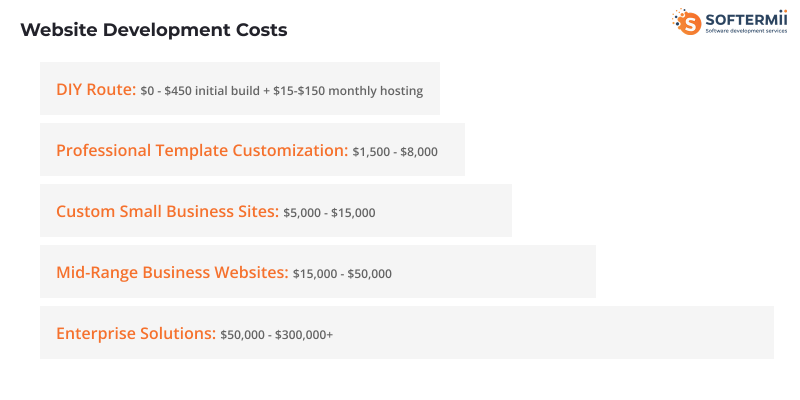


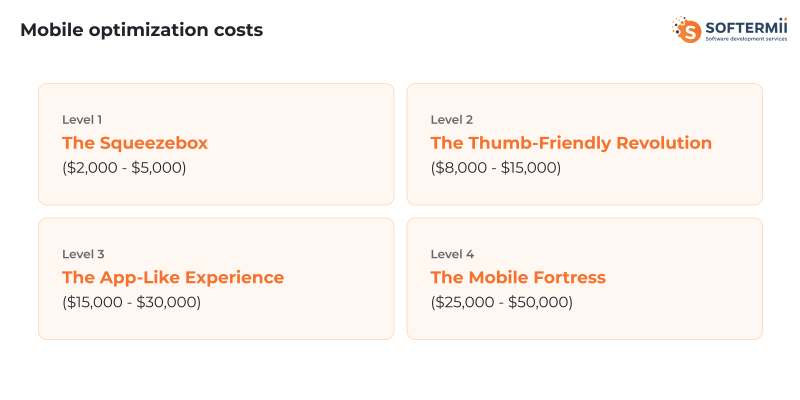

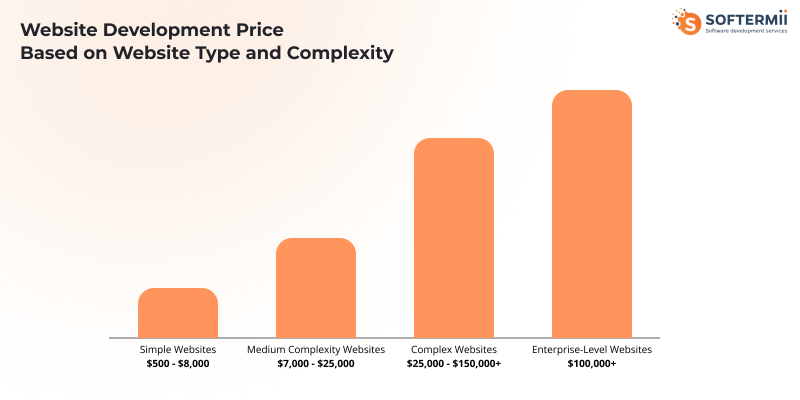
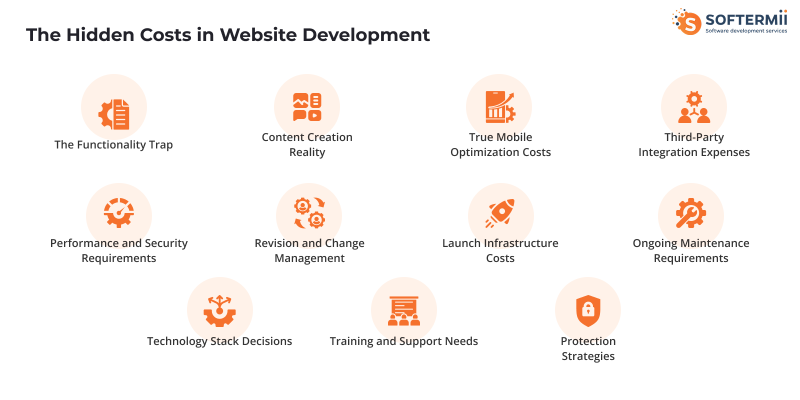
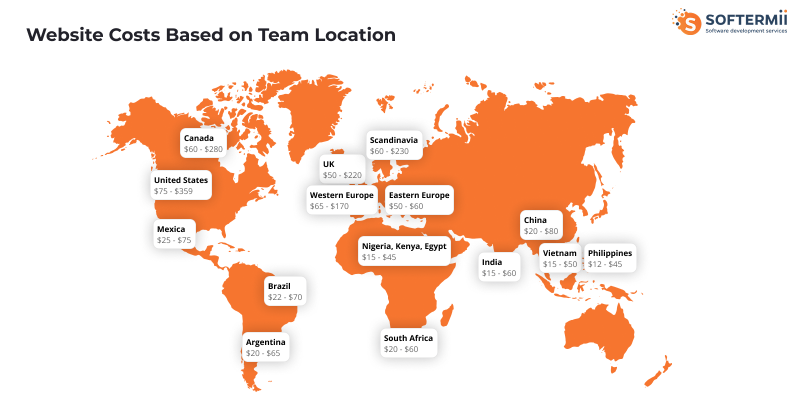
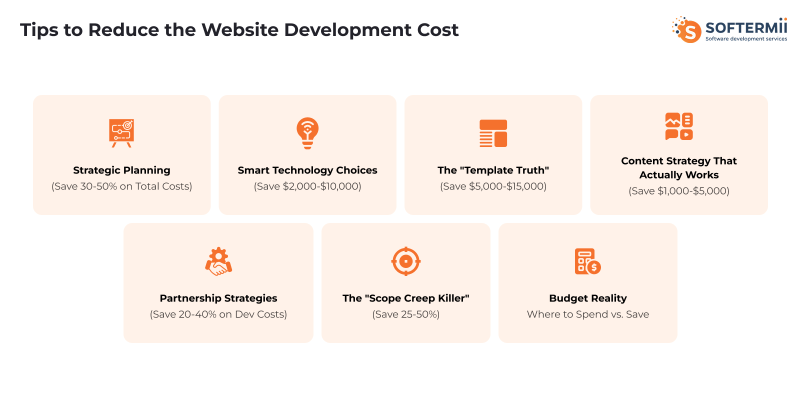

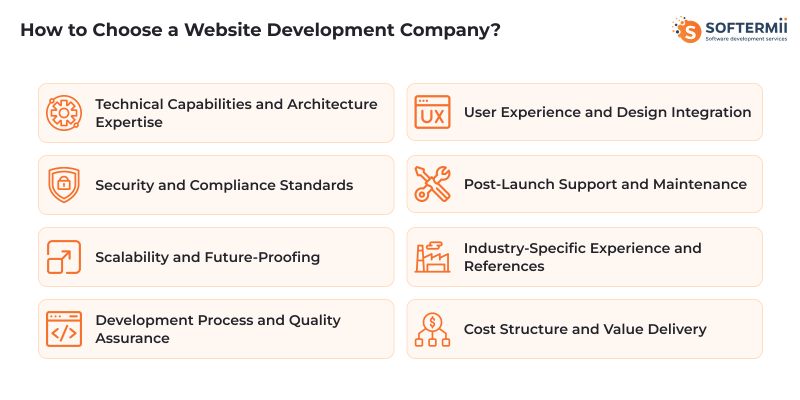
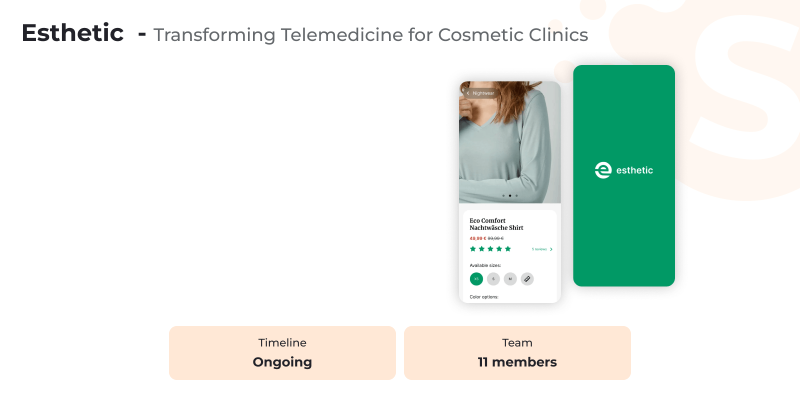








![Web Application Development Cost in 2025 [A Step-by-step Guide]](/assets/uploads/blog/20251030/cover-small.png)


